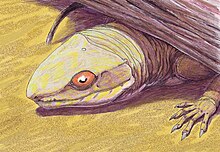Oedaleops
|
Oedaleops Temporal range: Early Permian |
|
|---|---|
 |
|
| Restoration of Oedaleops campi | |
| Scientific classification | |
| Kingdom: | Animalia |
| Phylum: | Chordata |
| Clade: | †Caseasauria |
| Family: | †Eothyrididae |
| Genus: |
†Oedaleops Langston, 1965 |
| Type species | |
|
†Oedaleops campi Langston, 1965 |
|
Oedaleops is an extinct genus of caseasaur synapsid from the Early Permian of the southwestern United States. Fossils have been found in the Cutler Formation in New Mexico, which dates back to the Wolfcampian stage of the Early Permian. All remains belong to the single known species Oedaleops campi. Oedaleops was closely related to Eothyris, and both are part of the family Eothyrididae. Like Eothyris, it was probably an insectivore.
Oedaleops was first described by paleontologist Wann Langston, Jr. in 1965 on the basis of a mostly complete skull (specimen UCMP 35758, the holotype of Oedaleops) and a few isolated skull and postcranial fragments. The UCMP 35758 skull has been the sole specimen of Oedaleops used in most analyses of its evolutionary relationships. The more fragmentary specimens have been assigned to Oedaleops with caution because they are hard to distinguish from the bones of other Cutler Formation synapsids such as Aerosaurus. Additional specimens of Oedaleops were described in 2013, including many isolated dentaries (lower jaw bones), pectoral and limb bones, and disarticulated vertebrae representing at least three new individuals.
Oedaleops has a wide and low skull with a convex margin when viewed from the side. It has large orbits or eye sockets and numerous teeth, the most of any caseasaur. It differs from its closest relative Eothyris in having a frontal bone that forms a greater portion of the upper margin of the orbit. Another distinguishing feature of Oedaleops is the thinness of the postorbital bar, a strut of bone separating the back of the orbit from a hole in the back of the skull called the temporal fenestra. Oedaleops lacks the enlarged caniniform teeth and blunt snout of Eothyris.
...
Wikipedia
